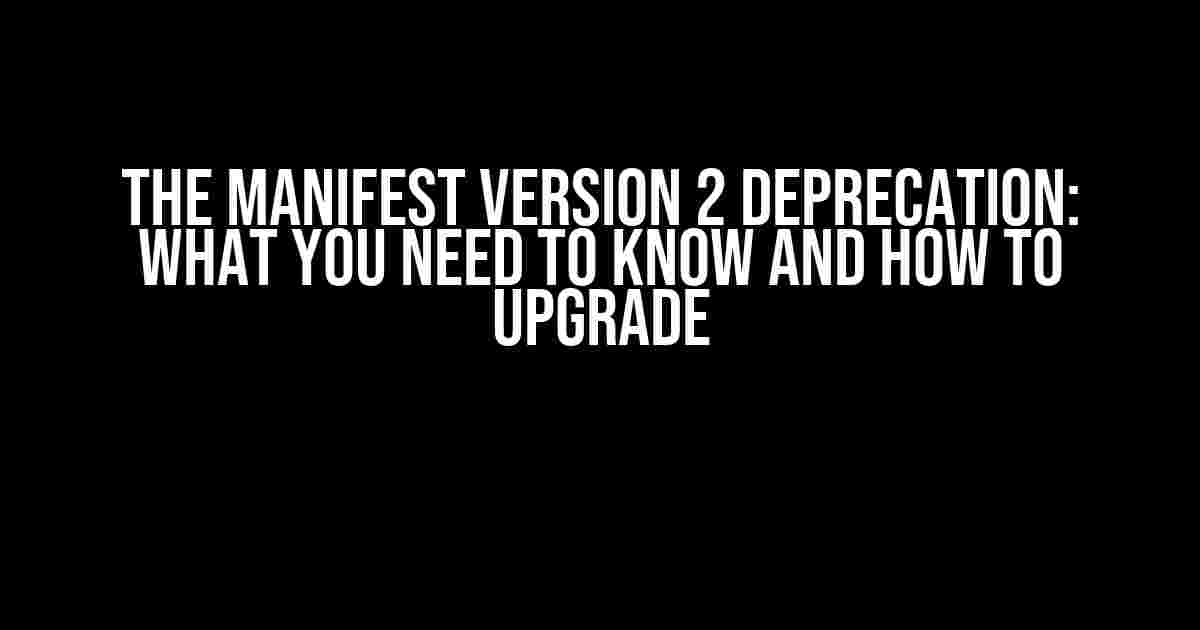Are you a developer who’s been using Manifest Version 2 (MV2) for your Chrome extensions? Well, it’s time to bid farewell to the old and welcome the new! As of January 2023, Manifest Version 2 is officially deprecated, and it’s essential to upgrade to Manifest Version 3 (MV3) to ensure your extensions remain compatible and secure.
Why is Manifest Version 2 deprecated?
Google deprecated MV2 due to security concerns and the need for better performance. MV2 had several limitations, including:
- Lack of content script injection control, making it vulnerable to security breaches
- Inefficient resource handling, leading to slow performance
- Limited support for modern web technologies
What are the key differences between Manifest Version 2 and Manifest Version 3?
MV3 brings significant changes to the Chrome extension architecture. Here are the main differences:
| Feature | Manifest Version 2 | Manifest Version 3 |
|---|---|---|
| Content Script Injection | Allowed | Restricted (requires explicit permission) |
| Background Pages | Allowed | Replaced by Service Workers |
| Resource Handling | Inefficient | Improved with Service Workers |
| Support for Modern Web Tech | Limited | Improved (e.g., support for ES6+ and modern JavaScript features) |
How to upgrade to Manifest Version 3
Upgrading to MV3 requires significant changes to your extension’s architecture. Follow these steps to ensure a smooth transition:
- Migrate to Service Workers: Replace background pages with service workers, which handle background tasks and resource management.
- Update your manifest file: Modify your manifest.json file to conform to the MV3 specification.
- Use the new permissions system: Request explicit permissions for content script injection and other features.
- Update your JavaScript code: Adapt to the new MV3 APIs and modern JavaScript features.
- Test and debug: Thoroughly test your extension to ensure compatibility and functionality.
Migrating to Service Workers
// Example service worker code
self.addEventListener('install', (event) => {
event.waitUntil(
caches.open('my-cache').then((cache) => {
return cache.addAll([
'/index.html',
'/styles.css',
'/script.js',
]);
}),
);
});
self.addEventListener('fetch', (event) => {
event.respondWith(
caches.match(event.request).then((response) => {
return response || fetch(event.request);
}),
);
});
Updating your manifest file
// Example manifest.json file
{
"manifest_version": 3,
"name": "My Extension",
"version": "1.0",
"description": "A brief description of my extension",
"permissions": ["activeTab", "storage"],
"service_worker": "worker.js",
"content_scripts": [
{
"matches": ["*://*/*"],
"js": ["contentScript.js"],
},
],
}
Requesting permissions
In MV3, you need to request explicit permissions for features like content script injection. Add the required permissions to your manifest file:
"permissions": ["activeTab", "storage", "scripting"],
Adapting to the new JavaScript APIs
MV3 introduces modern JavaScript features and APIs. Update your code to use these new APIs:
// Example code using the chrome.scripting API
chrome.scripting.executeScript({
target: { tabId: tab.id },
injection: 'document_end',
func: () => {
// code to be injected
},
});
Conclusion
The deprecation of Manifest Version 2 marks a significant shift in the Chrome extension ecosystem. By following this guide, you’ll be able to upgrade your extensions to Manifest Version 3, ensuring they remain compatible, secure, and efficient. Remember, the future of Chrome extensions is built on MV3, so don’t wait – start your upgrade journey today!
Additional resources:
- Chrome Extension Documentation: https://developer.chrome.com/docs/extensions/
- Manifest Version 3 Migration Guide: https://developer.chrome.com/docs/extensions/mv3-migration/
- Chrome Extension Forum: https://groups.google.com/a/chromium.org/g/chromium-extensions/
Stay up-to-date with the latest Chrome extension development news and best practices by following official Chrome extension channels and participating in the developer community.
Frequently Asked Question
Android developers, listen up! You might have seen the dreaded “Manifest version 2 is deprecated” warning in your AndroidManifest.xml file. Don’t worry, we’ve got you covered! Here are some frequently asked questions to help you navigate this issue.
What does “Manifest version 2 is deprecated” even mean?
Don’t worry, it’s not as scary as it sounds! “Manifest version 2 is deprecated” simply means that the old way of writing AndroidManifest.xml files (version 2) is no longer supported and will be removed in future Android updates. It’s time to upgrade to version 3!
What happens if I don’t upgrade to Manifest version 3?
Well, if you don’t upgrade, your app might not work as expected (or at all!) in future Android updates. You might even get rejected from the Play Store! Upgrade to Manifest version 3 to ensure your app stays compatible and secure.
How do I upgrade to Manifest version 3?
Easy peasy! Just update your AndroidManifest.xml file to use the new `xmlns:android` namespace (`xmlns:android=”http://schemas.android.com/apk/res/android”`). You can also use Android Studio’s built-in “Migrate to AndroidX” tool to help with the transition.
What are the benefits of upgrading to Manifest version 3?
Upgrading to Manifest version 3 brings a host of benefits, including improved security, better app compatibility, and support for new Android features. You’ll also get improved performance and a sleeker app overall!
I’m a beginner developer, help! Where can I learn more about Manifest version 3?
Don’t worry, we’ve got you covered! Check out the official Android documentation for Manifest version 3, as well as Android Studio’s built-in guides and tutorials. You can also search for online courses, YouTube tutorials, and developer communities for help.
